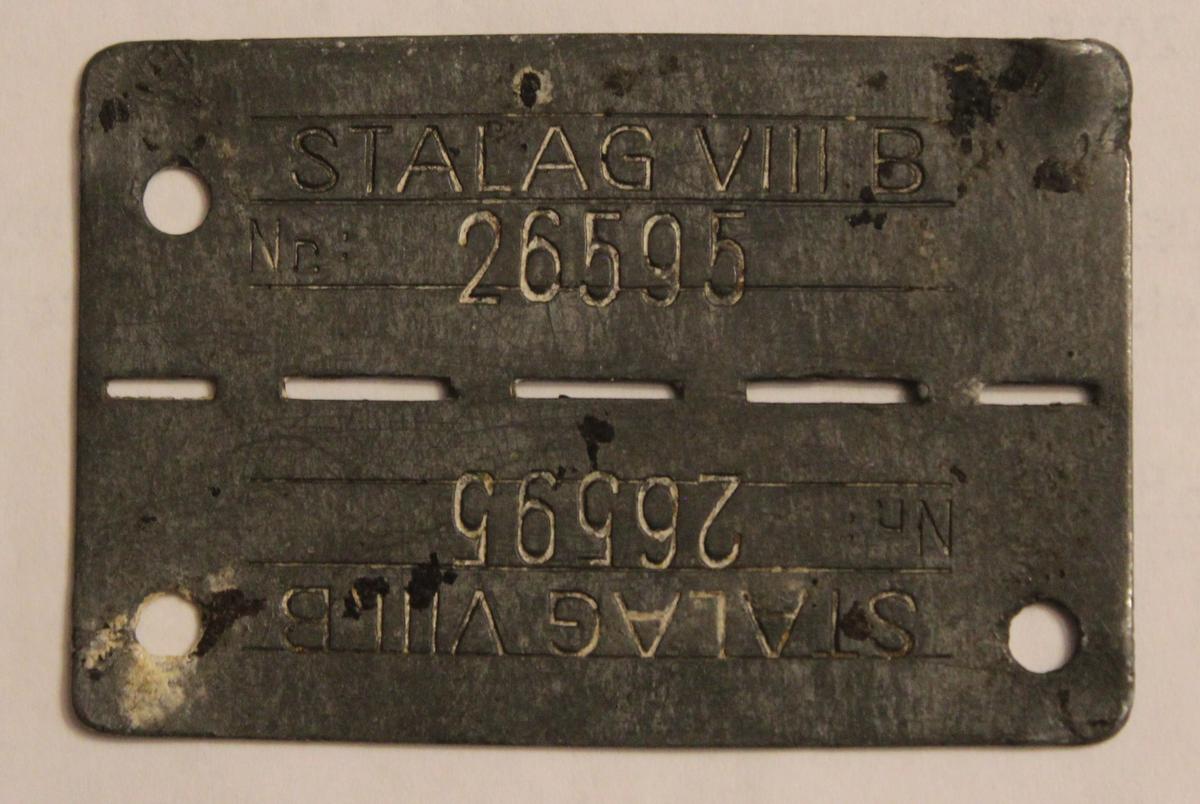Prisoner of War Forced Marches, 1945

Dog tags belonging to Pte. L. MacCallum from when he was a prisoner of war at Stalag VIII B.
After the Battle of Dieppe on 19 August 1942, many Canadian soldiers were taken as prisoners of war (POW) by the German army. In contrast to the sixteen men from the 18th Battalion who were taken captive in World War I, 255 soldiers and seven officers from the Essex Scottish were taken prisoner at Dieppe alone. Additional soldiers were taken to the German camps after the Battle of Verrières Ridge in Normandy, France.
Prisoners of the German forces were in danger from the moment they were captured. Any movement by the prisoners that was perceived to be aggressive could lead to them being shot or beaten. If supplies could not be procured to feed and tend to them, they could be killed to eliminate the burden. Trains carrying prisoners of war were occasionally mistakenly targeted by Allied fighter pilots. These trains were ill-equipped to carry people so a minimum of forty men were in each cattle car in filthy conditions. The cars were not well-ventilated and the only place to use the washroom was a dirty milk can. Many of the troops had dysentery.
Most prisoners from the Essex Scottish were held at Stalag VIII B in Poland or Oflag VII B in Bavaria, Germany. Stalag VIII B, which housed other ranks, held over fifty thousand prisoners from Britain and the British Empire. Commissioned officers were held in Oflag VII B. While well-run, food was not plentiful, and fuel was prone to shortages in the winter. Food and cigarettes sent by the Red Cross could be used to barter with the guards, but it was often up to the ingenuity of the prisoners to remedy problems posed by a lack of supplies in the camp. For example, prisoners made bricks of coal last longer by inventing a “blower” to prolong its heat.
The movement of prisoners from one camp to another, often in forced marches, was a perilous journey for the prisoners. As the Russian army was advancing on German territory in early 1945, prisoners in camps close to the encroaching armies were moved to camps closer to the western front. These marches could be as long as 1600 kilometres. They lasted from January to May 1945. Private Robert C. Large of The Essex Scottish stated that the Germans marched prisoners back and forth between the Eastern Front and the Western Front. Prisoners were shot if they fell out of line, which was common as they were often injured or starving. This action both punished prisoners for disobeying orders and set an example for the rest of the prisoners. These processions came to be known as The Death Marches.
The men were most often poorly dressed for the cold winter weather. Prisoners did whatever they could to stay alive while marching, including eating charcoal to prevent dysentery and stealing food from houses along the way. Supply crates from the Red Cross could not reach the men, so they were forced to live off the natural land to survive. They were joined by Russian prisoners, who slept in the same barns as them. This sleeping in close quarters led to infestations of body lice.
Allied planes that saw large groups of men in German territory were trained to treat them as hostile German soldiers. Allied planes dropped bombs and strafed them with machine guns. Corporal Harold Scharfe recalled a Mustang fighter plane’s attack on a march of POWs that was only aborted when the marching men formed the letters P.O.W. so that the pilot understood he would be firing on Allied soldiers. Walter McGregor also remembered three American fighter planes attacking POWs from Oflag VII B while they marched to Moosburg in Bavaria. This attack killed several offices and wounded one.
While the Germans might have said that for prisoners of war, the war was over, the fight for their lives under such terrifying conditions was one they would endure until they were liberated at the end of the war.
Story by Nicole Pillon, Canada Summer Jobs 2022 participant
with The Essex and Kent Scottish Regiment Association
Sources
- Duty Nobly Done: The Official History of the Essex and Kent Scottish Regiment by Sandy Antal and Kevin R. Shackleton, 2006: Chapter 13
- Personal Account of Robert C. Large
